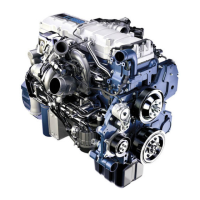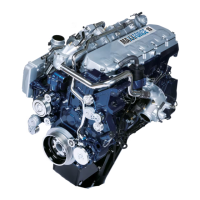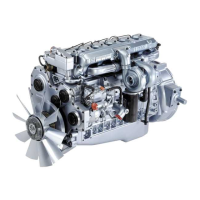146 5 HARD START AND NO START DIAGNOSTICS
2. Engine Cranking
Figure 167
Purpose
To determine the following:
• Does the crankshaft rotate?
• Does the instrument panel receive a signal from
the Electronic Control Module (ECM) and is rpm
sufficient?
• Is oil pressure sufficient?
• Is fuel getting into the cylinders?
Tools
• None
Procedure
WARNING: To avoid serious personal injury,
possible death, or damage to the engine or
vehicle, read all safety instructions in the “Safety
Information” section of this manual.
1. See “DT 466 Performance Specifications” –
Appendix A (page 595) or “DT 570 and HT 570
Performance Specifications” – Appendix B (page
619) for specifications, and enter data in spec
column for rpm and oil pressure on Diagnostic
Form.
2. TurntheignitionswitchtoSTART.
NOTE: If equipped, push optional push button to
crank engine.
3. Check rpm on instrume nt panel. Record results
on Diagnostic Fo rm.
• If engine speed is below specification, the
engine will not start. Check batteries and
DTCs if engine seems to be turning over fast
enough to start and no rpm is noticed on
instrument panel.
4. Check oil pressure (instrument panel). Record
results on Diagnostic Form.
• If oil pressure do es not build while c ra nking
the engine, oil may not be feeding the
high-pressure oil system. Check oil level.
5. Check for exhaust sm oke and record color on
Diagnostic Form.
NOTE: Typically smoke indicates that fuel is
getting into the cylinde rs. However, fuel pressure
should be measured to ensure sufficient fuel
supply.
• If there is no smoke from the exhaust during
engine crank, fuel may not be getting to
the engine cylinders. See “Priming the
Fuel System” in Section 4 (page 132) for
procedure.
Possible Caus es
Engine will not turn over
• Low or no battery power
• No key power (v
IGN
)
• Insufficient power to ECM
• Starting system failure
• Circuit fault for Engine Crank Inhibit (ECI)
• Cylinder hydraulic lock
EGES-270-1
Read all safety instructions in the "Safety Information" section of this manual before doing any proced ures.
Follow all warnings, cautions, and notes.
©August 2008 Navistar, Inc.

